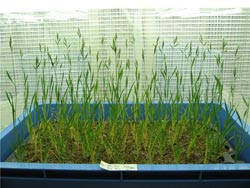RIKEN BioResource Center to provide seeds of model cereal plant

The model cereal plant Brachypodium distachyon<br>
Brachypodium distachyon belongs to the Poaceae family of monocot plants, which comprises temperate grasses and cereals and constitutes one of the most economically important plant families in the modern world. It is the first of the grass subfamily Pooideae to have a sequenced genome and it is widely used as a model plant for structural and functional genomic studies of grasses and cereals.
The seeds made available at BRC are of the Bd21 line, the standard line used in the sequencing project. In addition to the seeds, BRC will provide the scientific community with the technology needed for the cultivation and genetic alteration of Bd21.
“The BRC Brachypodium distachyon seed bank is the first of the kind in Asia. Our Bd21 seeds will be of particular interest to Asian scientists who can use it to generate transgenic plants and study monocot genes of agronomic interest.” Explains Dr. Kobayashi, Head of the Experimental Plant Division.
The Bd21 Brachypodium distachyon line is an important addition to BRC’s wide variety of bioresources, which already include human specimens, mice, the model plant Arabidopsis thaliana, cell lines, genes and microorganisms.
Since its establishment in 2001, the RIKEN BioResource Center has acted as a core bioresource facility for researchers through the collection, preservation and distribution of bioresources. Through these activities, the BRC supports studies in a broad range of fields, from basic research to the treatment of disease, health promotion, food production and environmental conservation.
http://www.riken.jp/en/pr/press/2013/20130405_2/
Media Contact
More Information:
http://www.riken.jpAll latest news from the category: Life Sciences and Chemistry
Articles and reports from the Life Sciences and chemistry area deal with applied and basic research into modern biology, chemistry and human medicine.
Valuable information can be found on a range of life sciences fields including bacteriology, biochemistry, bionics, bioinformatics, biophysics, biotechnology, genetics, geobotany, human biology, marine biology, microbiology, molecular biology, cellular biology, zoology, bioinorganic chemistry, microchemistry and environmental chemistry.
Newest articles

Superradiant atoms could push the boundaries of how precisely time can be measured
Superradiant atoms can help us measure time more precisely than ever. In a new study, researchers from the University of Copenhagen present a new method for measuring the time interval,…

Ion thermoelectric conversion devices for near room temperature
The electrode sheet of the thermoelectric device consists of ionic hydrogel, which is sandwiched between the electrodes to form, and the Prussian blue on the electrode undergoes a redox reaction…

Zap Energy achieves 37-million-degree temperatures in a compact device
New publication reports record electron temperatures for a small-scale, sheared-flow-stabilized Z-pinch fusion device. In the nine decades since humans first produced fusion reactions, only a few fusion technologies have demonstrated…





















